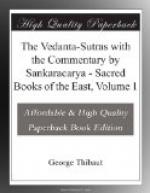Owing to the effects of their former actions the individual souls are implicated in the sa/m/sara, the endless cycle of birth, action, and death, final escape from which is to be obtained only through the study of the j/n/anaka/nd/a of the Veda. Compliance with the injunctions of the karmaka/nd/a does not lead outside the sa/m/sara; but he who, assisted by the grace of the Lord, cognizes—and meditates on—him in the way prescribed by the Upanishads reaches at his death final emancipation, i.e. he passes through the different stages of the path of the gods up to the world of Brahman and there enjoys an everlasting blissful existence from which there is no return into the sphere of transmigration. The characteristics of the released soul are similar to those of Brahman; it participates in all the latter’s glorious qualities and powers, excepting only Brahman’s power to emit, rule, and retract the entire world.
The chief points in which the two systems sketched above agree on the one hand and diverge on the other may be shortly stated as follows.—Both systems teach advaita, i.e. non-duality or monism. There exist not several fundamentally distinct principles, such as the prak/r/iti and the purushas of the Sa@nkhyas, but there exists only one all-embracing being. While, however, the advaita taught by Sa@nkara is a rigorous, absolute one, Ramanuja’s doctrine has to be characterised as visish/t/a advaita, i.e. qualified non-duality, non-duality with a difference. According to Sankara, whatever is, is Brahman, and Brahman itself is absolutely homogeneous, so that all difference and plurality must be illusory. According to Ramanuja also, whatever is, is Brahman; but Brahman is not of a homogeneous nature, but contains within itself elements of plurality owing to which it truly manifests itself in a diversified world. The world with its variety of material forms of existence and individual souls is not unreal Maya, but a real part of Brahman’s nature, the body investing the universal Self. The Brahman of Sa@nkara is in itself impersonal, a homogeneous mass of objectless thought, transcending all attributes; a personal God it becomes only through its association with the unreal principle of Maya, so that—strictly speaking—Sa@nkara’s personal God, his I/s/vara, is himself something unreal. Ramanuja’s Brahman, on the other hand, is essentially a personal God, the all-powerful and all-wise ruler of a real world permeated and animated by his spirit. There is thus no room for the distinction between a param nirgu/n/am and an apara/m/ sagu/n/am brahma, between Brahman and I/s/vara.—Sa@nkara’s individual soul is Brahman in so far as limited by the unreal upadhis due to Maya. The individual soul of Ramanuja, on the other hand, is really individual; it has indeed sprung from Brahman and is never outside Brahman, but nevertheless it enjoys a separate personal existence and will remain a personality for ever—The




